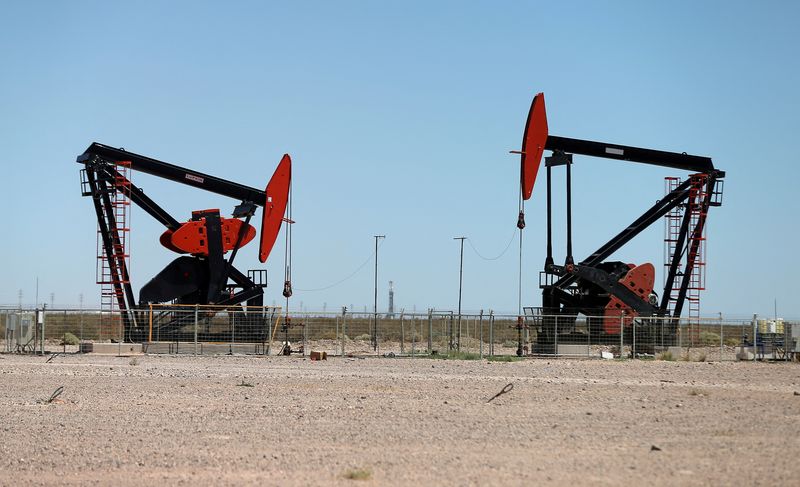Commodities
Oil settles higher on supply concerns in the Mideast, economic woes subdue gains

By Georgina McCartney
HOUSTON (Reuters) -Oil prices settled higher on Friday, garnering support from tensions in the Middle East, but a strong dollar and U.S. inflation data quashed hopes that the Federal Reserve would cut interest rates soon, giving prices a ceiling.
futures settled up 49 cents, or 0.55%, to $89.50 a barrel. U.S. West Texas Intermediate crude futures settled up 28 cents, or 0.34%, to $83.85 a barrel.
Supply concerns supported prices as tensions continue in the Middle East.
Benjamin Netanyahu, Israel’s prime minister, said any rulings by the International Criminal Court, which is investigating Hamas’ Oct. 7 attacks on Israel and Israel’s military assault on Gaza, would not affect Israel’s actions but would “set a dangerous precedent.”
As tensions escalate, Israel’s military said on Friday that its air force struck in Lebanon’s West Beqaa District and killed a militant who advanced attacks against Israel.
Israel stepped up air strikes on Rafah on Thursday after saying it would evacuate civilians from city in southern Gaza and launch an all-out assault despite allies’ warnings that doing so could cause mass casualties.
“Israel is not afraid to come and support themselves on their own if they have to, people are watching to see what happens between Netanyahu and Biden,” said Tim Snyder, chief economist at Matador Economics.
“The geopolitical element is not over, the proxy battles going on right now will continue,” and this is still providing support and helping to offset the negative pressure from the inflationary data, Snyder added.
remove ads
.
Meanwhile, macroeconomic pressures capped gains after data released on Friday showed growing inflation.
In the 12 months through March, U.S. inflation rose 2.7% after an advance of 2.5% in February. Last month’s increase was broadly in line with economists’ expectations.
The Fed has a 2% inflation target. The U.S. central bank is expected to leave rates unchanged at its policy meeting next week.
“The economic data this morning was enough for market participants to conclude that the Fed is not going to be forthcoming with interest rate cuts any time soon,” said John Kilduff, partner with Again Capital LLC.
“Geopolitical jitters in the market are what is keeping us aloft. Those two competing forces should keep us in check,” Kilduff added.
U.S. Treasury Secretary Janet Yellen told Reuters on Thursday that U.S. GDP growth for the first quarter could be revised higher, and inflation will ease after a clutch of “peculiar” factors held the economy to its weakest showing in nearly two years.
U.S. economic growth was likely stronger than suggested by the weaker quarterly data, Yellen said. Oil prices have flip-flopped since Yellen’s comments and the release of the inflation data on Friday.
Meanwhile, the dollar soared to a fresh 34-year high against the yen on Friday, bolstered in part by the U.S. inflation data.
“Dollar strength is helping to exert negative pressure today,” Kilduff said.
Elsewhere, OPEC Secretary General Haitham Al Ghais said in an op-ed article that the end of oil is not in sight, as the pace of energy demand growth means that alternatives cannot replace it at the needed scale, and the focus should be on cutting emissions not oil use.
remove ads
.
Commodities
Oil prices rise; U.S. crude inventories plunge, Russia-Ukraine truce eyed
Commodities
India’s Reliance to stop buying Venezuelan oil over US tariffs, sources say
Commodities
Oil prices climb on Venezuela supply worries

 Forex3 years ago
Forex3 years agoForex Today: the dollar is gaining strength amid gloomy sentiment at the start of the Fed’s week

 Forex3 years ago
Forex3 years agoUnbiased review of Pocket Option broker

 Forex3 years ago
Forex3 years agoDollar to pound sterling exchange rate today: Pound plummeted to its lowest since 1985

 Forex3 years ago
Forex3 years agoHow is the Australian dollar doing today?

 Cryptocurrency3 years ago
Cryptocurrency3 years agoWhat happened in the crypto market – current events today

 World3 years ago
World3 years agoWhy are modern video games an art form?

 Commodities3 years ago
Commodities3 years agoCopper continues to fall in price on expectations of lower demand in China

 Economy3 years ago
Economy3 years agoCrude oil tankers double in price due to EU anti-Russian sanctions























